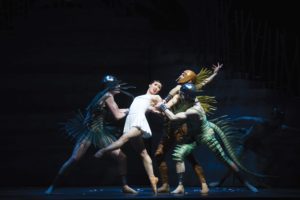Melbourne: Winter 2019 - Vancouver Ballet Society
- Home
- City Reports 2015 - 2019
- Melbourne: Winter 2019

By Rhys Ryan
One year after Lucas Jervies’ gladiatorial epic Spartacus, audiences of the Australian Ballet were again thrust into the wonders of the ancient world. This time, brutality and hypermasculinity were replaced with an intricate plot of heroism and triumph in the company’s co-production with Houston Ballet, Sylvia, which had its Australian premiere at the Arts Centre Melbourne in August.
Since its original Parisian premiere in 1876, Sylvia has spent much of its life on the repertoire shelf, known mostly for a handful of standalone musical movements from Léo Delibes’ score. Long criticized for its thin, convoluted plot, the ballet has been entirely reimagined by Australian-born choreographer and director of Houston Ballet, Stanton Welch.
It was a briskly paced work that followed intertwining stories of desire and conquest led by three heroines — warrior nymph Sylvia, goddess Artemis and the mortal Psyche. The plot was anything but simple, full of cameos and convoluted character arcs. But Welch’s storytelling was precise and efficient, marrying well with Delibes’ melodic score and offering clear narrative arcs for the audience to follow.
The treble narrative was also well served by Jérôme Kaplan’s versatile and minimalist grotto-like set. Neutral tones and subtle textures offered a blank canvas for colourful and detailed projections, which allowed the characters to jump seamlessly from the clouds of Olympus to the rolling hills of Arcadia to the flames of Hades. Many of Wendall K. Harrington’s projections were beautiful, but occasionally obscured the dancing, particularly in the first act.
The lead ballerinas on opening night — Australian Ballet principals Ako Kondo (Sylvia) and Robyn Hendricks (Artemis), plus senior artist Benedicte Bemet (Psyche) — showed formidable technical and dramatic form. Their embodiment of character offered depth and substance, creating three separate but equally powerful identities.
Senior artist Marcus Morelli was a standout as Psyche’s love interest, Eros. With his gravity-defying allegro and precise turns, Morelli showed a true mastery of control and explosiveness.
Welch’s choreography was academically classical and highly energetic. Strong hieroglyphical shapes and the open arm line were cleverly used as an embodiment of ancient militaristic symbolism, most effectively shown by Artemis’ corps of battle-ready nymphs.
These ensemble moments, paired with Delibes’ rousing brass fanfares, were some of the most exciting sections of the work. We felt the strength of the women warriors as a united group and their appetite for power. But an underused corps de ballet meant these moments were infrequent. Delibes’ score, though tuneful and littered with wonderful leitmotifs, lacked the emotional gravitas needed to sweep us off our feet.
Welch’s storytelling, too, turned inwards. Rather than offering allegory and metaphor, his Sylvia remained within the confines of its narrative structure, reverting to the hallmarks of a conventional story ballet. While political comment is not always necessary, having seen the potential for ancient stories to be reimagined for a contemporary context in last season’s Spartacus, it felt like a missed opportunity, especially given there were three powerful women in the lead roles.
A week before the Australian premiere of Sylvia, the Arts Centre Melbourne was overtaken by the experimental arts festival Supersense. Several dance works were programmed, most notably I hunger for you, created by New York choreographer Kimberly Bartosik and her ensemble daela.
Through a series of episodic chapters, her cast of five dancers explored themes of ecstasy, ritual and desire. The work offered a visceral portrait of the inner self, drawing inspiration from internalized forces of faith and Bartosik’s own experience with charismatic spirituality.
The dancers ran wildly, balanced and fell, and tossed their limbs in repetitive circular loops. Jubilation was followed by thrusting, shaking and tremors — all manifestations of uncontrolled impulses.
An interesting dimension of the work was Bartosik’s consideration of spectatorship. The house lights remained up for the whole piece and, midway through, a young girl walked onstage to sit and watch the dancers. We became unavoidably aware of our role as spectators, voyeurs of the deeply personal corporeal exorcisms occurring onstage.
Despite its clunky staging and lighting — largely because of the attempt to fit a black-box work into an indoor amphitheatre — I hunger for you offered a compelling take on human desire and its outward expression.
Also at Supersense was Australia’s small but exhilarating component of the Cunningham Centennial Solos, arranged by Dylan Crossman and performed by three dancers (Christian Allen, Burr Johnson and Lindsey Jones). Unlike the major celebrations in London, Los Angeles and New York, here the excerpts were cleverly staged in an intimate, semi-immersive setting, allowing us to closely observe every tilt, curve and jump.
Presenting Cunningham’s work as a pop-up performance in an experimental arts festival was an unusual curatorial choice. But the movement’s ever-surprising inventiveness and challenging gymnastic quality was enough to impress both the dance enthusiasts and those new to his work.
Seeing Cunningham’s radical approach to form was also a refreshing counterpoint to less academic aesthetics that have progressively defined the contemporary dance scene, at least in Melbourne.

Photo: Jeff Busby
